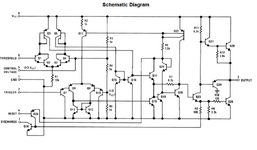NigthMoth
Member level 1

Dear all
Please help me understand this unusual(?) 555 Monostable configuration in which 555's Trigger pin and trigger pulse source
connected together via reverse biased diode. There is a lot of explanations for similar monostable configuration without diode on the web, but I can't find any with that diode installed.
I found this type of circuit on page 161 in book "Mechatronics for the evil genius" by N. C. Braga, 2006. ("Project 17 - Robot with sensors").
At first, i thought this circuit couldn't work as monostable multivibrator, because D1(and D2) is reverse biased and I should mentally replace it with opened switch. This way there is no voltage on TRIG pin -> no voltage on 555's inner Trigger comparator inverting input ->
inner Trigger comparator is always HIGH -> 555's inner Flip-Flop's "S" is always HIGH.
And when THRESH pin > 2/3 V+, inner Flip-Flop's "R" also becomes HIGH and Fli-Flop goes to undefined state.
Moreover, closing "sensor" switch changes nothing: D1 becomes forward biased and connects TRIG to ground forsing inner Trigger comparator and inner Flip-Flop's "S" to HIGH, but they already HIGH and always HIGH because of reverse biased diode?
I built similar circuit (with transistor Led driver instead of relay) and it works.
But I not sure why.
I found that there is still 10-30uA current through D1 in both directions when pushing and releasing SW1 button.
I guessed that D1 acts like coupling capacitor and I tryed to change D1 to 0.001uF capacitor in my circuit, and this circuit with capacitor instead of D1 also works well.
So there are my questions:
1) Why and how this monostable multivibrator with diode D1 works and what is the role of D1 for it's performance?
2) If D1 acts as coupling capacitor, why not just use a capacitor instead of diode?
3) If it is known and common practice for some particular purposes to connect TRIG pin with diode , kindly provide me with links with explanations when such diode should be used (Googling doesn't help, or maybe I cant formulate search pharase in correct way)
Here is pictures of my circuit with details.
Please help me understand this unusual(?) 555 Monostable configuration in which 555's Trigger pin and trigger pulse source
connected together via reverse biased diode. There is a lot of explanations for similar monostable configuration without diode on the web, but I can't find any with that diode installed.
I found this type of circuit on page 161 in book "Mechatronics for the evil genius" by N. C. Braga, 2006. ("Project 17 - Robot with sensors").
|
|
At first, i thought this circuit couldn't work as monostable multivibrator, because D1(and D2) is reverse biased and I should mentally replace it with opened switch. This way there is no voltage on TRIG pin -> no voltage on 555's inner Trigger comparator inverting input ->
inner Trigger comparator is always HIGH -> 555's inner Flip-Flop's "S" is always HIGH.
And when THRESH pin > 2/3 V+, inner Flip-Flop's "R" also becomes HIGH and Fli-Flop goes to undefined state.
Moreover, closing "sensor" switch changes nothing: D1 becomes forward biased and connects TRIG to ground forsing inner Trigger comparator and inner Flip-Flop's "S" to HIGH, but they already HIGH and always HIGH because of reverse biased diode?
I built similar circuit (with transistor Led driver instead of relay) and it works.
But I not sure why.
I found that there is still 10-30uA current through D1 in both directions when pushing and releasing SW1 button.
I guessed that D1 acts like coupling capacitor and I tryed to change D1 to 0.001uF capacitor in my circuit, and this circuit with capacitor instead of D1 also works well.
So there are my questions:
1) Why and how this monostable multivibrator with diode D1 works and what is the role of D1 for it's performance?
2) If D1 acts as coupling capacitor, why not just use a capacitor instead of diode?
3) If it is known and common practice for some particular purposes to connect TRIG pin with diode , kindly provide me with links with explanations when such diode should be used (Googling doesn't help, or maybe I cant formulate search pharase in correct way)
Here is pictures of my circuit with details.


